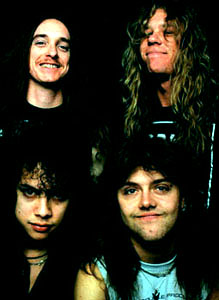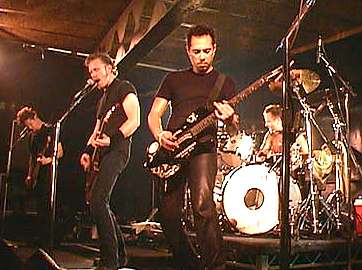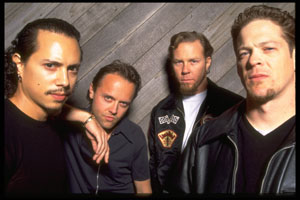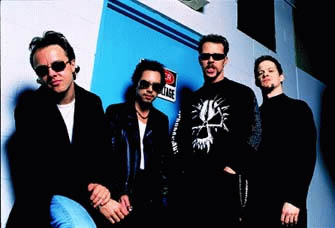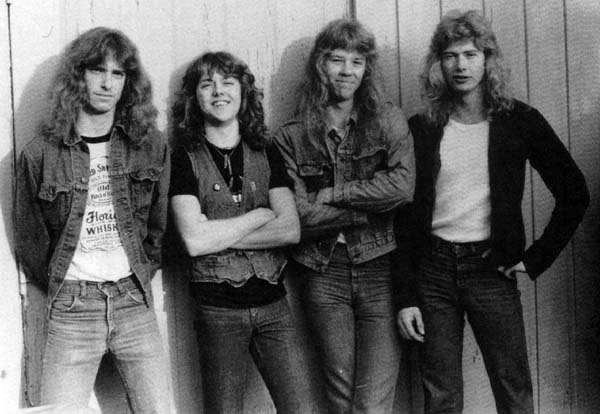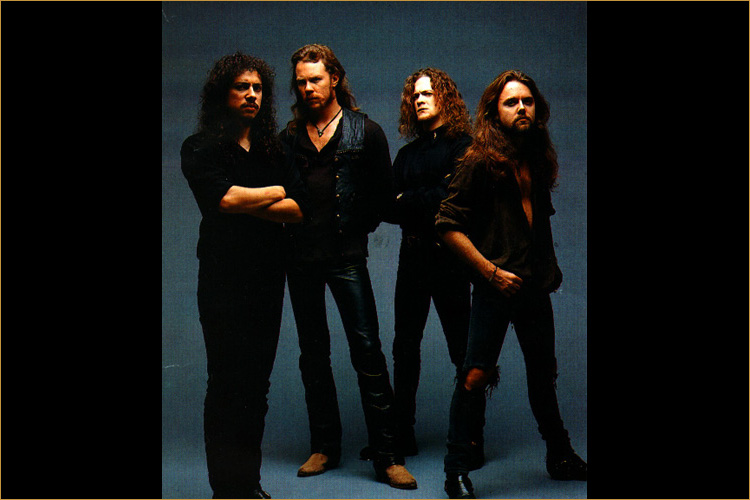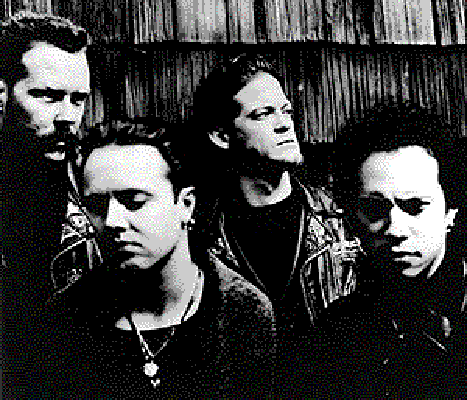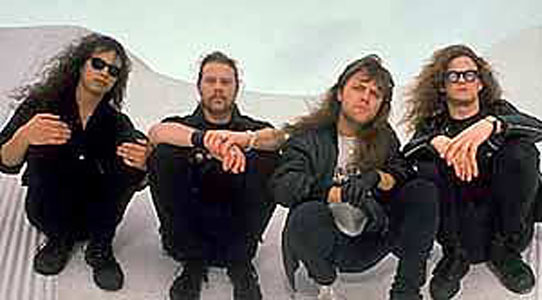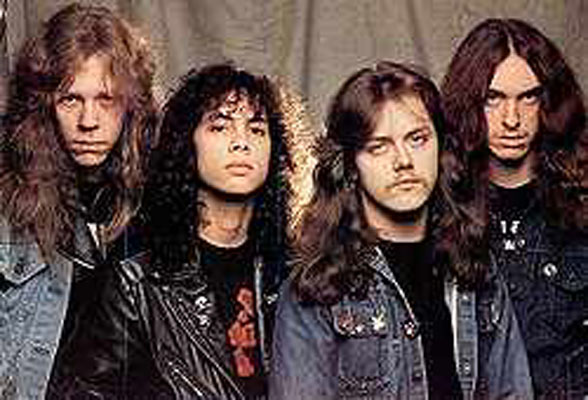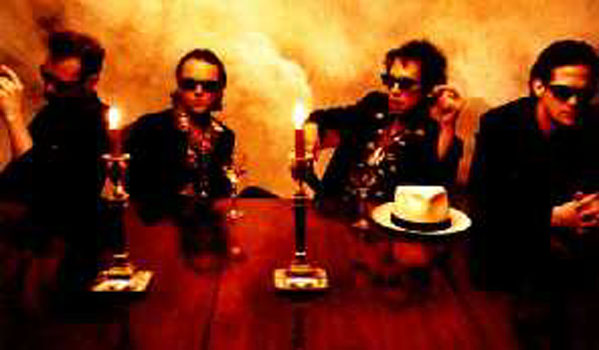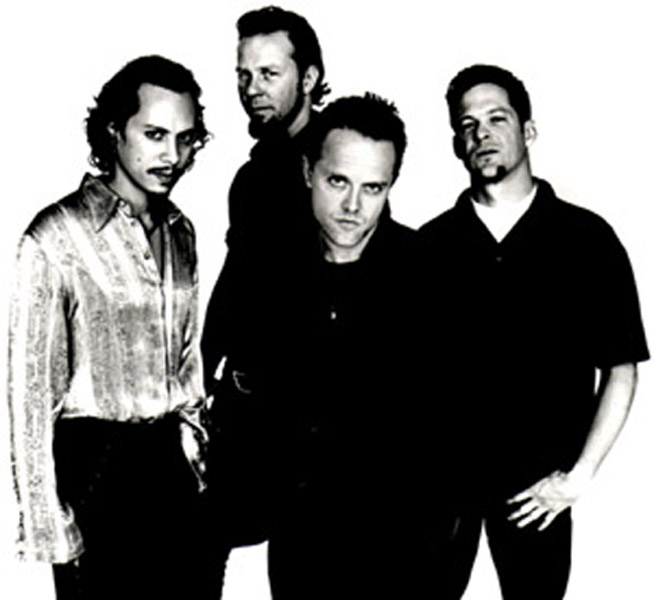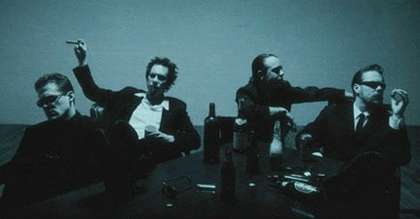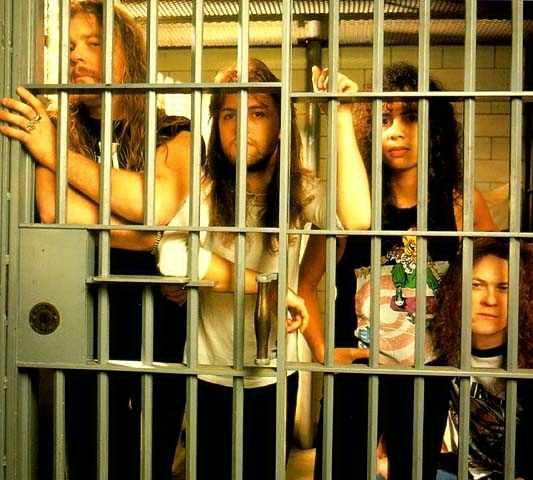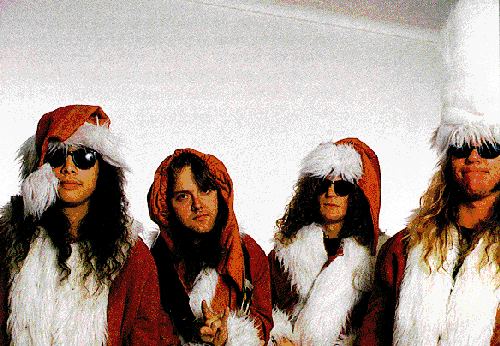Sorry, these aren't in any order, but you can kinda guess by the lengths of their hair as to when they were taken.
Band Biography:

Sorry, these aren't in any order, but you can kinda guess by the lengths of their hair as to when they were taken.
Band Biography:

In 1980, Lars Ulrich was trying to form a band and placed an ad in a magazine called Recycler. James Hetfield responded and the two met to jam, but they did not form a band until 1981. Lars had "a track saved for [his] band on Brian Slagel's new Metal Blade label" and asked James and Lloyd Grant to join him on tour with Diamond Head for 3 months.
In 1982, Metallica played their first show at Radio City, Anaheim, CA. They recorded four tracks together. Then, the demo, No Life ‘Til Leather was recorded including the songs, "Hit the Lights," "Mechanix," "Motorbreath," "Seek and Destroy," "Metal Militia," "Jump in the Fire," and "Phantom Lord." These songs also included Ron McGovney, James’ friend and housemate, on bass. They picked up Cliff Burton on bass in replace for Ron McGovney in 1982 (under the condition that the band move to San Francisco instead of Los Angeles).
Jon Zazula, in New York, got a copy of No Life ‘Til Leather and invited Metallica to record an album and play some shows. Zazula started his own record label, Megaforce Records, and signed Metallica as the first band. In 1983, New York, the band picked up Kirk Hammet, a member of Exodus, on guitar. They recorded Kill ‘Em All, their first album.
Metallica toured, playing songs from Kill ‘Em All. They also began writing songs for their next album, Ride the Lightning, which was " a more mature album," but maintained the same style as their previous album. "Fade to Black" is one of the songs on this album and was written in response to the theft of Metallica’s equipment when they were in Boston. The album was released in 1984 with Megaforce Records.
Metallica signed with Q Prime and then to major record label Elektra. The band released Master Of Puppets in 1986 and toured with Ozzy Osbourne. Their popularity grew steadily and this was their last tour as a supporting act. James broke his wrist in a skateboarding accident and John Marshall had to play guitar for the band on tour, while James continued to do vocals.
On September 27, 1986, Metallica was driving between Stockholm and Copenhagen when one of their tour buses began swerving violently. It ended up 60 feet up the road, on its side in a ditch. Most of the passengers made it out of the wreckage, including James Hetfield, Lars Ulrich and Kirk Hammet. The police determined that the crash was a result of ice on the road. However, Cliff Burton, 24 years old, was dead. James Hetfield stated, in 1993, "I saw the bus lying right on him. I saw his legs sticking out. I freaked. The bus driver, I recall, was trying to yank the blanket out from under him to use for other people. I just went, 'Don't f***ing do that!' I already wanted to kill the guy. I don't know if he was drunk or if he hit some ice. All I knew was, he was driving and Cliff wasn't alive anymore."
Metallica persisted as a group of three. They turned to alcohol to deal with the pain. After returning to America, they began auditioning for a new bass guitar player. Jason Newstead, in hopes of joining the band, memorized all of their songs in just a few days and was chosen out of 40 other auditions to be the new member on October 28, 1986.
With Jason established, the band went back to record their fourth full-length album, "...And Justice For All," released in August 1988. It reached #6 on the US charts, and received a Grammy nomination for Best Metal/Hard Rock album.
The band took the show back out on the road and toured extensively to all parts of the world. "...And Justice For All" produced two US singles and the band's very first venture into music video for the song "One." They finally won a Grammy for the One single.
In 1991 Metallica released the self titled "black album." With new producer Bob Rock, this album was a departure from the previous album. The songs were shorter and the sound was fuller, deeper and less monotone. The "black album" went straight to number one all over the world... and stayed there for several weeks.
The album spawned several singles and videos and remains the most successful Metallica album to date. The band won several awards including a Grammy for the album and several MTV and American Music Awards.
The band toured and toured and toured playing all alone in "An Evening With Metallica" or with Guns N' Roses (where James got in a fire accident), or as headliner at many festivals. Metallica took the Black Album (and the other songs as well) to the people.
Five years would pass before the next Metallica album saw the light. The album was called Load and was the longest Metallica album to date. With 14 songs it took all available room on a compact disc. The album was again produced by Bob Rock, as was ReLoad, which followed in 1997. Both albums were written and mostly recorded together, and continued what the self-titled album started.
With the completion and subsequent touring for Load and ReLoad and quite possibly the end of this phase of Metallica, it's natural only to become somewhat introspective. While lyrically the Load albums reflected a great deal of what lies inside each of us emotionally and subconsciously, it came a time to look into what made this band.
No greater reflection of what makes Metallica "Metallica" are their influences. And as they did in 1981 when they started, 1984 with Garage Days Revisited and 1987 with Garage Days Re-Revisited, the band did what comes naturally... they went back to the garage.
The band chose 11 new songs to record its third "in the garage" project, again with Bob Rock. The project was aptly-titled Garage Inc. as it incorporates ALL the previously-recorded garage cover songs along with the 11 new tracks.
In 2000, the recorded the song "I disappear" for the "Mission Impossible II" soundtrack. The song was released on the internet through Napster in MP3 form before it was released to the radio. Metallica began a battle against Napster which eventually went to the sentate.
